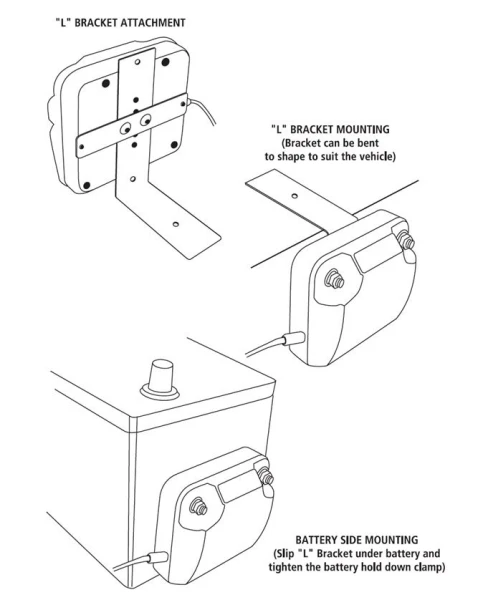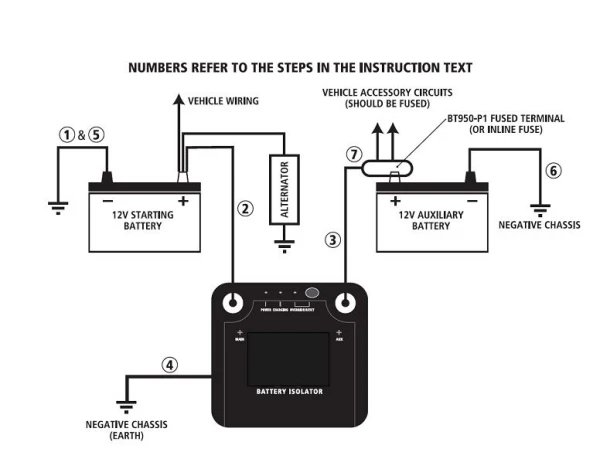User's Manual for Battery Isolator
Warning for the Battery Isolator
- PLEASE READ THESE INSTRUCTIONS COMPLETELY PRIOR TO INSTALLATION.
- BATTERIES PRODUCE EXPLOSIVE GASES - Ensure no sparks or flames are present.
- Wear eye protection.
- Vehicles must be in “NEUTRAL ”or “PARK ”, park brakes “ON ”
- Follow all vehicle manufacturers’ instructions.
- Beware of moving parts.
- Battery Isolators are designed for negative ground alternator systems with batteries of the same nominal voltage.
- Batteries of differing voltages cannot be used.
Features of the Battery Isolator
- Easy to Install - The electronic isolator does not require any changes to the vehicle’s existing wiring. It can be fitted to all 12V vehicle types.
- Priority Charging for Starting Battery - Ensures that the starting battery is fully charged before connecting the auxiliary battery in parallel.
- Manual Override - If the starting battery is flattened and the auxiliary battery is charged, the electronic isolator allows the batteries to be manually paralleled to jumpstart the vehicle.
- Over-Current Protection – Protects the Isolator and charging system from over current damage, which could occur due to a short circuit in the wiring.
- Surge Protection - Provides surge protection for vehicles with electronic ignition/ management systems.
Specifications of the Battery Isolator
| PART NO. | #20090 | #20092 |
| VOLTAGE | 12V | 12V |
| CHARGING | 75A/100A peak | 125A/150A peak |
| CURRENT | ||
| CHARGE TYPE | Parallel | Parallel |
| CONTROL | Electronic | Electronic |
| MOUNTING | Surface/firewall/battery side | Surface/firewall/battery side |
| CURRENT DRAW | Charging 500mA (Standby 30mA) |
Charging 500mA (Standby 30mA) |
| VOLTAGE DROP | None | None |
| SURGE | Built in | Built in |
| PROTECTION |
Items Needed
- Charged auxiliary battery - Deep cycle recommended for most applications
- Auxiliary battery cradle & battery clamp
- Battery terminals & lugs
- 150A fuse or circuit breaker
- Battery cable
- 14mm² (6 B&S) minimum for engine bay mounted auxiliary batteries (up to 3m)
- 20mm² (4 B&S) for rear of vehicle / trailer mounted auxiliary batteries.

Installation of the Battery Isolator– Connection
To make the electrical connections, battery cables will need to be made to the correct length using cable lugs and heat shrink. Cable lugs should be crimped or soldered to the stripped battery cable and then protected with the heat shrink.- Disconnect the negative battery cable (Earth) from the vehicle’s starting battery. Note: To prevent the loss of vehicle electronic memories, radio presets & security codes, it is recommended that an “Electrical System Memory Protector” be used.
- Connect a length of cable from the ‘MAIN’ (+) terminal on the isolator to the positive battery terminal on the starting (main) battery.
- Connect a length of cable from the ‘AUX’ (+) terminal on the isolator to the positive battery terminal of the auxiliary battery. The connection at the Auxiliary battery should be fused using a ‘Fused’ battery terminal or a 150 Amp fuse or circuit breaker mounted inline. If using (Fused distribution terminal) the connection from the battery isolator should be made to main (large) fuse stud. Do not over-tighten the terminal studs on the electronic isolator.
- Connect the isolator’s ‘Earth’ wire (small black wire with ring terminal) to a suitable chassis bolt or screw, ensure the ring terminal will make a good electrical connection by removing any paint.
- Reconnect the starting (main) battery’s negative cable (Earth), the isolator should now flash the red ‘power‘ LED.
- Connect a length of cable (of suitable size, commonly 2 B&S) from the vehicle’s chassis or engine block to the negative terminal of the auxiliary battery as a ground cable (Earth), the isolator should now show a solid red ‘power’ LED.
- Connect all of the auxiliary loads (phone, lights, stereo, refrigerator, etc.) to the positive battery terminal of the auxiliary battery, use appropriate circuit protection fuses.

Testing for Normal Operation
- With the installation complete and the engine ‘Off’ only the red ‘Power’ LED should be on.
- Start the vehicle’s engine. Within a few seconds the blue ‘Charging’ LED will turn on indicating that the starting battery is above 13.4V and the isolator will start charging the auxiliary battery.
- If the isolator does not go into ‘Charging mode’ within a few seconds, increase the engine RPM to a fast idle. This will allow the alternator to generate more current.
- Once the Isolator is in ‘Charging mode,’ turn the engine ‘Off’, then switch the headlights and other accessories ‘On’. The isolator will now detect that the batteries are being used. 60 seconds after the voltage falls below 12.8V, the blue ‘Charging’ LED will turn off and the isolator will disconnect the two batteries from each other.
Operation
Automatic
Once the Battery Isolator has been correctly installed and tested it will function automatically to charge the auxiliary battery.Manual Override
If the starting battery is flat and the auxiliary battery is charged, the battery isolator can be used to connect both batteries to allow jumpstarting.- Press the ‘Override/Reset’ button on the top of the isolator, the green ‘Override/Reset’ LED will illuminate.
- Crank the engine, once the engine has started the unit will automatically cancel the override function and return to the automatic charging function.
- If you wish to stop the override function manually press the ‘Override/Reset’ button.
| ISOLATOR STATUS |
LED OPERATION |
AUX BATTERY |
OPERATING CONDITIONS |
| NORMAL AUTMATIC OPERATION | |||
| Standby |

|

|
Both batteries are above 7.5V indicating correct connection and the isolator is monitoring the starting battery. |
| Start Charging |

|

|
When the starting battery is above 13.4V indicating that the engine is running & the auxiliary battery is above 3V (i.e properly connected) the isolator starts charging the auxiliary battery. |
| Stop Charging |

|

|
When the starting battery drops below 12.8V for more than one minute indicating that the engine is turned off and the batteries are not running any appliances, it may take a few hours for the battery voltage to drop below 12.8V. This is normal and will not cause any problems to the operation or charging of your dual battery system. |
| OVERRIDE OPERATION | |||
| Start Override |

|

|
Press the 'override/reset' button to manually connect the auxiliary battery to the starting battery. Both batteries must be above 7V for this mode to operate. |
| Stop Override |

|

|
The override mode can be stopped manually by pressing the push button at any time. The override will also automatically stop after 3 minutes or when the unit detects that the starting battery is above 13.4V indicating that the engine has started. |
| FAULT | |||
| Auxiliary Battery Fault |

|

|
The power LED will flash indicating that the Aux batter is either:
|
| Charging Over-current |

|

|
Excessive current flowing while in charging mode. Over-current can be reset by pressing the 'Override/reset' button or will automatically reset when the starting battery is below 12.8V indicating that the engine has stopped. |
| Override over-current |

|

|
Excessive current flowing while in override mode. Over-current can be reset by pressing the 'override/reset' button or will automatically reset when the starting battery is above 13.4V indicating that the engine has started. |
